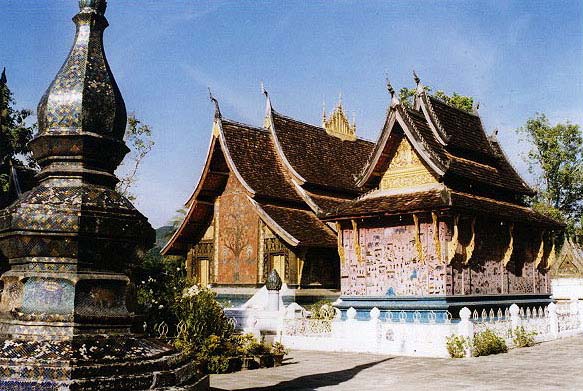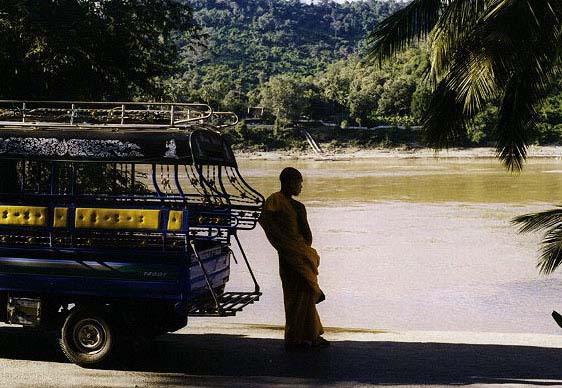
Kingdom of a Million Elephants
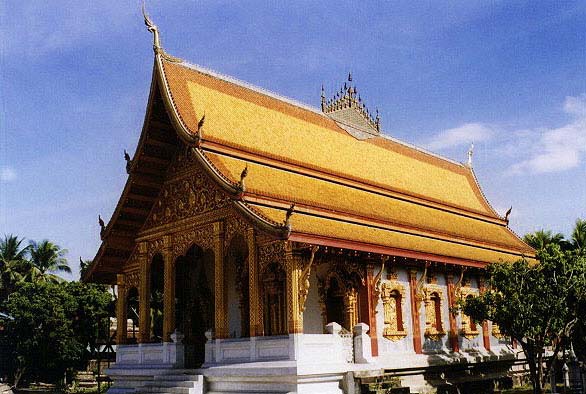 |
| Wat Nong Sikhonmeuang, Luang Prabang |
The next morning we woke up early and caught a ride to the Vientiane airport. We hadn't called to confirm our flight, so we got bumped. It was no big deal; the next flight was leaving in a few hours. We spent the morning writing in our journals, smiling at kids, and eating bread. As the morning progressed, more and more people poured into the waiting room. They carried baskets of live fish, sacks of baguettes, and plastic bags bursting with green plants. Around 11AM, we boarded the Lao Aviation plane, a retired Soviet plane from the 1950's complete with faded Russian writing on the wings and no seat belts. The baskets of live fish were stacked in the back, and as I stepped on board, I felt a splash of water on my cheek.
Luang Prabang (essentially pronounced long pah-bong) is without doubt the most mellow, relaxed, friendly and tranquil city I have ever visited. Located in the northern reaches of Laos, Luang Prabang was founded by King Fa Ngum in 1353. This was the very heart of Lane Xang, the Kingdom of a Million Elephants. Today, the monarchy is gone, but the city still possesses a noble mystique. Palm leaves line the narrow roads. Gilded wats stand on every corner. Countless monks go about their daily chores. The city takes its shape from the Mekong, as it hugs the muddy shoreline. Less than 300 yards from the river, sits Mount Phousi (poo see), a large hill that anchors the town. Phousi is crowned with the golden Wat Chom Phousi; from afar, it looks like the gateway to Xanadu.
stand on every corner. Countless monks go about their daily chores. The city takes its shape from the Mekong, as it hugs the muddy shoreline. Less than 300 yards from the river, sits Mount Phousi (poo see), a large hill that anchors the town. Phousi is crowned with the golden Wat Chom Phousi; from afar, it looks like the gateway to Xanadu.
We stayed at the Phousi Hotel, right at the base of the hill. On the hotel verandah, French tourists sipped cocktails and sat barefoot in rattan lawn chairs. At night the hotel was lit with strings of white bulbs. In the daytime, butterflies drifted through the garden.
The most amazing thing about this city is its familiarity. Everything about it is foreign to me, but somehow everything just felt right. I automatically fell into its ambling pace. Without thinking I acclimated to its natural friendliness. Within a few days, we knew the shop keepers and their children. Even in my American hiking boots and gortex jacket, I felt like a part of the community.
 |
| A boy leaning out of a French colonial window |
Wats are literally at every turn, down every dirt road and side street, behind every curve in the road. Monks sweep the grounds with straw brooms. A young novice hangs a saffron robe out to dry. An elderly monk shaves his chin while sitting on the stairs of his wat. Another old monk hangs out a window and exhales his cigarette into a beam of sunlight. Chickens strut down side streets that ramble down to the water. Along the riverbank, fishermen string their nets. Boys sink their oars into the muddy Mekong and push their father's longboats into the current.
Luang Prabang is less than 100 miles from China, and you can feel it. Women wear the pointed rice bowl hats. Banisters are sculpted and painted to look like long red dragons. Black pillars encrusted with lines of gold shine when the sun hits them.
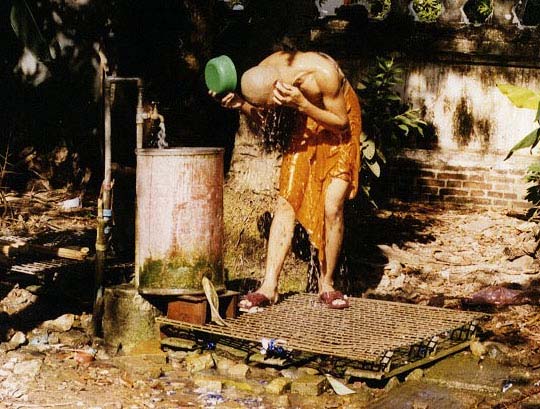 |
| A novice shaves his head, Wat Saen |
At Wat Saen, I ducked into a clump of trees behind one of the shrines. Hard beams of sunlight broke through the palm trees and fell, to my surprise, on two young monks, half clothed and heads shaven. Water dripped from their bare chests onto the saffron cloth wrapped around their waists. Clearly, I'd stumbled into some kind of outdoor washroom. They were splashing their faces with water from a large metal bucket when I walked in. I was afraid I had invaded their territory or embarrassed them. Monks are allowed only limited interaction with women - they can't even take something from a woman's hand. I wei'd them; that is I pressed my palms together and bowed. They both burst into wide smiles. One of them put his hand on his head and declared, "Shiny hair."
I thought maybe he was referring to my blond hair. I smiled and nodded, "Shiny hair." They both looked at most 17 years old. The talkative one wanted to know my name, where I was from and where I had been. I asked their names, and then apologized for wandering in on them. The talkative one sat down on a wooden bench and explained, "Today is the day we shave our heads." So when he'd said "shiny hair," he was probably talking about his own freshly shaven head.
We said good-bye, in English and Lao. The monks went back to washing, and Andy and I turned the corner onto a dirt road. A little girl ran up and shook my hand. "Hello," she declared proudly. "Sabai dee (suh-buy-dee)," I answered in Lao. She laughed and ran away. We continued down the road to Wat Xieng Thong, one of the most important wats in Luang Prabang.
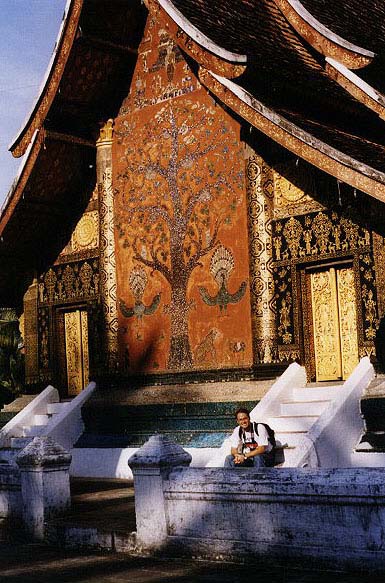 |
| Andy at Wat Xieng Thong, Luang Prabang |
Beyond the chariot temple stood an open-air hut with a large hanging drum and several smaller gongs. Scanning over the blossoming trees, past the Chinese-lion statues that guard the steps to the riverbank, my eyes were magnetized to the wat's main sim. It is truly impressive. The roof is terraced so that each level sweeps down and reaches out farther than the last. Wat Xieng Thong was built during the height of the Kingdom of a Million Elephants, and today it is a perfectly preserved relic of grace and power.
It is truly impressive. The roof is terraced so that each level sweeps down and reaches out farther than the last. Wat Xieng Thong was built during the height of the Kingdom of a Million Elephants, and today it is a perfectly preserved relic of grace and power.
